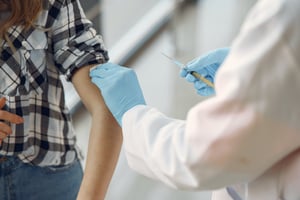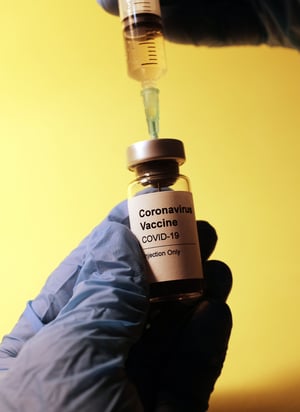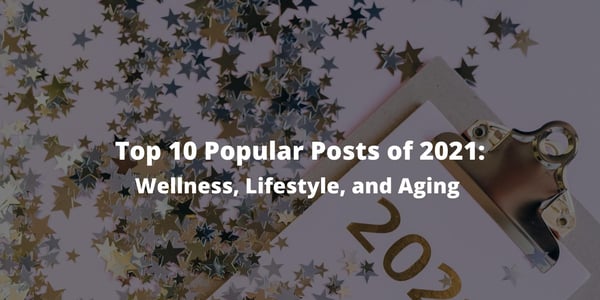Should we accept pain as a normal part of aging?
Chronic tension/pain has become an epidemic across...
Note: This post has been updated May 17, 2021.
Even though the COVID-19 virus continues to spread, the U.S. vaccination process is cause for decreased transmission rates nationwide. Nearly one-third of the U.S. population, above the age of sixteen, are fully vaccinated, with an average of two million tests administered daily. In the last two weeks, daily reported cases of infection are down 29.7%. There are currently three FDA unapproved vaccines under Emergency Use Authorization (EUA), including the Pfizer-BioNTech, Moderna, and Johnson and Johnson’s Janssen vaccine.
The Pfizer-BioNTech and Moderna vaccines are both classified as mRNA vaccines. Unlike other vaccines, this type does not inject the virus into an individual. Instead, mRNA vaccines create a protein that triggers an immune response to produce antibodies. Obtaining antibodies for COVID-19 protects individuals from getting infected when they come in contact with the virus.
 This vaccine, developed by Pfizer, a pharmaceutical company, is recommended to those sixteen and older. This vaccine has proven prevention from COVID-19 to those that complete the vaccination process. This vaccine is administered as a shot in the muscle of the upper arm in two doses, three weeks apart. The side effects of the Pfizer-BioNTech vaccine include::
This vaccine, developed by Pfizer, a pharmaceutical company, is recommended to those sixteen and older. This vaccine has proven prevention from COVID-19 to those that complete the vaccination process. This vaccine is administered as a shot in the muscle of the upper arm in two doses, three weeks apart. The side effects of the Pfizer-BioNTech vaccine include::
Pfizer-BioNTech is the first of the three COVID-19 vaccine producers to request full FDA approval for its vaccine. To receive FDA approval, the Pfizer-BioNTech vaccine had to prove that its benefits outweighed the risks. Even though approved, the Pfizer-BioNTech vaccine can now only be administered to those sixteen and older. Pfizer-BioNTech also the first vaccine makers seeking Emergency Use Authorization for children aged 12 to 15-years-old.
This vaccine, developed by Moderna, a biotechnology company in Cambridge, Massessussets, is recommended to those eighteen or older. It is recommended to be used by those over the age of eighteen years old. This vaccine also has proven prevention from COVID-19 to those that complete the vaccination process. This vaccine is administered as a shot in the upper arm in two doses, one month apart. Similar to the Pfizer-BioNTech product, side effects associated with the Moderna vaccine include::
 Injection site pain
Injection site painDuring clinical trials, people more often experienced side effects after the second dose. Still, side effects can show up after either or both doses.
The J&J/Janssen vaccine, developed by the Janssen Pharmaceutical Companies of Johnson & Johnson, is the first single-dose COVID-19 vaccine. The FDA approved the vaccine under Emergency Use Authorization on February 27th, 2021, for individuals 18 years of age and older.
Unlike the Pfizer-BioNTech and Moderna vaccines, the J&J/Janssen vaccine is not an mRNA vaccine. Instead, the J&J/Janssen vaccine uses traditional virus-based technology to deliver instruction to the immune system, teaching it to fight off the virus if encountered. Even though this vaccine is more convenient than the other two vaccines, the Phase 3 Ensemble study provided evidence indicating that the single-shot vaccine is 85% effective, compared to 94% effectiveness for the Pfizer-BioNTech and Moderna vaccines.
On April 13th, 2021, the CDC and FDA released a joint statement regarding the J&J/Janssen vaccine. This statement announced that six recipients of this vaccine developed a blood clot called cerebral venous sinus thrombosis (CVST) and low levels of blood platelets (thrombocytopenia). The J&J/Janssen vaccine was put on pause to investigate these cases and assess the significance of these developments. After a three-week pause, the CDC recommended that the vaccine resume after determining that the benefits outweigh the potential risks to women under the age of 50-years-old. Other than these rare cases, the side effects associated with the J&J/Janssen vaccine are the same as the Pfizer-BioNTech and Moderna vaccines.

While these vaccines are up to 94% effective, they will not end the COVID-19 pandemic unless vaccine adoption rates are high. This will be a challenge because the United States has had low adoption rates in other cases. For example, only 49.2% of Americans got the flu shot between 2018 and 2019, even though the vaccine’s safety, effectiveness, and availability have been proven for decades. Recent research shows that 63% of respondents are cautious about receiving a COVID-19 vaccination. Another 18% say they are unlikely to get vaccinated. Another factor that decreases the likelihood of high vaccine adoption rates is the uncertainty shown by healthcare workers. Although many healthcare workers are required to get vaccinated, 34% of nurses would not voluntarily be vaccinated. In comparison, only 15% of nurses are “very confident that a COVID-19 vaccine will be safe and effective”.
A method for working around this challenge is for healthcare workers to understand the necessity of being vaccinated, even if they doubt the vaccines. An example of this is my mom, a nurse at Abbott Northwestern Hospital in Minneapolis, MN. Regarding the vaccine, she said, “Although I am a bit nervous about receiving a brand new vaccine, I definitely believe this is the only way that we, as a country, will get out of this pandemic.”
Since many Americans doubt the safety of the COVID-19 vaccines, it must be communicated that all vaccines go through rigorous clinical trials to receive FDA approval for large-scale use. These vaccines will prevent individuals from becoming seriously ill and lower the spread of COVID-19 in the United States. By receiving a vaccine, people can also protect their loved ones at a higher risk of mortality if they develop COVID-19.
The more people that get vaccinated, the higher the chance of stopping the pandemic. While health and safety are the main benefits, there is also an economic benefit to being vaccinated. High vaccine adoption rates will increase safety to participate in social activities, which will enable strong economic growth and lead back to normalcy.
For additional information about current COVID-19 vaccines, visit the following websites:
Related content:

Should we accept pain as a normal part of aging?
Chronic tension/pain has become an epidemic across...


Entering retirement opens up a world of possibilities, where pursuing hobbies becomes an essential...

Finding hobbies that match your interests is an extraordinary method to ease pressure and challenge...